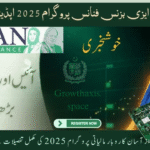Recenty government lunch the CM Punjab Asaan Karobar Card Scheme When my small café in Faisalabad began showing signs of stagnation—plates stacked up, supplier calls piling in, and cash flow tighter than ever—I was desperate for capital. Traditional banks wanted swathes of collateral, high interest rates, and weeks of paperwork. Then I stumbled upon the CM Punjab Digital SME Card Scheme: an entirely digital, interest-free loan card offering up to PKR 1 million. Intrigued, I decided to document every step of my journey to help fellow entrepreneurs. Here’s my in-depth, candid account—complete with lessons learned, best practices, and pitfalls to avoid.
1. Why This Scheme Stood Out for Me
- Zero Percent Interest: Saving up to PKR 200,000 in interest compared to informal lenders.
- Fully Digital Process: No mountains of paperwork or tedious branch visits.
- Revolving Credit Card Model: Use, repay, and re-use within the first 12 months.
- Structured Repayment: A 3-month grace period, followed by zero-interest EMIs.
I realized this could be more than a loan—it could be a tool to modernize my café, build a stronger credit profile, and free up cash for marketing and renovations.
2. Doing My Homework: Understanding the Scheme’s Blueprint
Before diving in, I spent an afternoon dissecting the official brochure and FAQs on the portal (https://akc.punjab.gov.pk/cmpunjabfinance). Key takeaways:
| Feature | Details |
|---|---|
| Maximum Limit | PKR 1,000,000 |
| Tenure | 3 Years total |
| Revolving Period | 12 Months |
| Grace Period for Repayment | 3 Months |
| EMI Period | 24 Equal Monthly Installments (post Revolving) |
| Processing Fee | PKR 500 (Non-Refundable) |
| Annual Card Fee | PKR 25,000 + FED |
| Cash Withdrawal Limit | 25% of sanctioned limit |
| Usage Restrictions | Only business-related expenses |
I jotted down several questions: How strict is the physical verification? What if I missed an EMI? Is PRA/FBR registration truly mandatory? Answering these upfront gave me confidence as I began my application.
3. Self-Check: Am I Truly Eligible?
I ran through the Eligibility Criteria multiple times to avoid surprises:
- Age: 21–57 (I’m 42).
- Residency: Living in Faisalabad, Punjab.
- Nationality: Pakistani CNIC.
- Business Location: My café, located in a busy Faisalabad market.
- Credit History: No overdue loans; I’d cleared my only previous micro-loan six months earlier.
- Psychometric Assessment: Digital questionnaire to gauge financial behavior.
Tip: If your credit history has a blemish, consider clearing that first—applications with overdue loans get rejected outright.
4. Late-Night Application Marathon
One evening, I settled at my desk with two goals: finish the form and pay the fee. Here’s how I tackled it:
- Step 1: Personal Details
- Name, CNIC, date of birth, mobile number for OTP.
- Step 2: Business Snapshot
- Café name, address, trade license number, rough monthly turnover.
- Step 3: Bank Account
- IBAN for fund transfers and auto-debit setup.
- Step 4: Document Upload
- Scanned CNIC, trade license, utility bill PDF.
Within three clicks, I paid PKR 500 via my mobile wallet. The portal confirmed receipt: “Your application (Ref: SMECARD12345) has been submitted successfully.”
5. Riding the Rollercoaster: Verification Updates
Over the next week, I received SMS alerts punctuating my anticipation:
- Day 1: “CNIC Verification Successful.”
- Day 3: “Credit & Psychometric Assessment Cleared.”
- Day 5: “Physical Verification Scheduled.”
An Urban Unit officer arrived at my café on Day 6, noted down daily sales estimates, verified utility bills, and clicked a few perimeter photos. His friendly demeanor put me at ease. The entire visit took just 20 minutes.
Tip: Display your trade license and recent bills at the counter; it speeds up the physical check.
6. The Big Moment: Collecting My Card
On Day 10, I got: “Your Digital SME Card is ready for pickup at Allied Bank, Gulberg Branch.” I collected it next morning—a sleek, chip-embedded card labeled “Punjab SME.” It felt empowering, like a passport to new business possibilities.
- First Tranche: PKR 500,000 unlocked immediately
- Grace Period: No repayments due for the first 3 months
I activated the card in the mobile app and played around with the dashboard—daily balances, transaction history, and EMI schedule all at my fingertips.
7. Deploying the First PKR 500,000
With half my limit in hand, I prioritized high-impact investments:
- Inventory Boost
- Ordered bulk beans, milk, syrups—secured a 10% supplier discount.
- Shop Facelift
- Repainted walls, added pendant lights, and bought three comfy armchairs.
- Digital Menu Board
- Installed a small LED menu screen for promotions and daily specials.
Within two weeks, footfall inched up by 15%, and impulse orders (coffee plus pastry) jumped noticeably.
Tip: Allocate at least 60% of your first tranche to revenue-generating assets or promotions for quick ROI.
8. Maximizing Card Features
The scheme allows various transaction modes:
- POS Payments: Seamless for high-value supplier invoices.
- Mobile App Transfers: Instant fund allocation to vendors.
- Cash Withdrawal: Up to 25% of limit (I kept it around 10% for emergency petty cash).
I linked autopay for monthly utility bills—no more manual transfers. The real-time ledger helped me spot a duplicate electricity charge right away, which I disputed and got reversed in two days.
Tip: Use the transaction tagging feature, if available, to categorize payments (e.g., “Supplies,” “Renovation,” “Utilities”).
9. Navigating the Grace Period
Months 1–3 were blessedly repayment-free. I focused on improving sales, fine-tuning my menu, and training staff. I also:
- Subscribed to a POS analytics plugin to understand peak hours.
- Ran a “refer a friend” promo via social media.
By Month 3, my daily sales had climbed from PKR 8,000 to PKR 11,500 on average—exactly the momentum I needed before EMI kick-off.
10. Setting Up for EMI Season
Thirty days before the grace period ended, the app sent a reminder: “Your first EMI of PKR 25,000 is due on [Date].” I immediately scheduled an auto-debit from my bank account.
- Minimum EMI: 5% of outstanding balance, but I opted for a slightly higher amount to close the balance faster.
- Avoiding Late Fees: I set a calendar alert 5 days prior to every due date.
Mortgages and personal loans taught me the pain of missed EMIs—this time, I was determined to stay spotless.
11. Unlocking the Second Tranche
After making three EMIs on time, the system automatically released the remaining PKR 500,000. To secure this:
- PRA Registration: I registered my café with the Punjab Revenue Authority in Month 2.
- Certificate Upload: Scanned and uploaded the PRA certificate on the portal.
Funds landed within 48 hours. I used this second tranche to launch a weekend “Coffee & Jazz” live-music event—a small but memorable investment that generated buzz and new clientele.
12. Long-Term Repayment: EMIs Over 24 Months
At the end of Month 12, the outstanding balance—around PKR 700,000 by then—converted into 24 equal EMIs at 0% interest. The monthly EMI amount appeared under the “Repayment Schedule” tab:
- EMI Amount: PKR 29,167
- Deduction Date: 5th of every month
I left the auto-debit in place, checked each transaction, and watched my balance steadily decline.
13. Pitfalls & How to Avoid Them
- Missed PRA Registration: Delays releasing second tranche—register within 6 months.
- Ignoring App Notifications: Missed a policy update on annual card fees—review messages promptly.
- Over-withdrawing Cash: Eating into working capital—keep cash withdrawals under 15% where possible.
Documentation and organization are your best defenses against these hiccups.
14. Reflections: The Scheme’s Impact on My Growth
- Sales Growth: A consistent 20% rise in monthly revenue over six months.
- Cost Savings: Zero interest saved me approximately PKR 180,000 compared to informal loans.
- Credit Profile Boost: My spotless EMI record positions me well for future larger-scale financing.
- Operational Efficiency: Digital payments reduced reconciliation time by 50%.
15. Final Checklist: Your Roadmap to Success
- Eligibility Audit: Confirm age, residency, and credit criteria upfront.
- Document Prep: Keep CNIC, trade license, utility bills, and bank IBAN ready.
- Apply Digitally: Complete the PITB e-Services form; pay PKR 500.
- Verify Premises: Ensure smooth physical verification with visible documents.
- Activate & Plan: Pick up your card; sketch a 3-month investment strategy.
- Automate Payments: Use auto-debit for EMIs and utility bills.
- Complete Registrations: PRA/FBR registration is non-negotiable.
- Track Transactions: Tag and review every expense within the app.
- Avoid Late Fees: Set reminders and honor each due date.
- Reinvest Wisely: Allocate funds to revenue-generating assets first.
Claiming the CM Punjab Digital SME Card was one of the most strategic decisions for my café. It delivered flexible, interest-free capital and a seamless digital experience, all while building my creditworthiness. If you’re a small entrepreneur in Punjab, follow these steps, stay organized, and let this scheme propel your business to the next level. Here’s to your entrepreneurial success!



